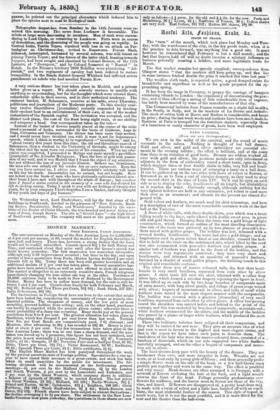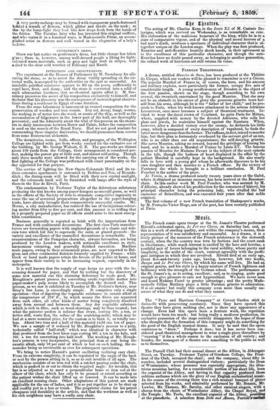PARIS FASHIONS.
(From our own Correspondent.)
We are now in the midst of the carnival, and the sound of music resounds in the salons. Nothing is thought of but ball dresses. Gold and silver, and gold and silver embroidery are essential ele- ments in the evening toilette ; the effect is brilliant, and at the sauce time there is no violation of good taste. Dresses are seldom worked all over with gold and silver; the precious metals are only introduced as adjuncts in the form of embroidery round a short tunic, open in front, which displays three or four double skirts in tulle, very full and bouil- lonnees. There are various ways of arranging a tunic on a ball dress. It can be gathered up on the two sides with bows of velvet or flowers, or festooned so as to form a sort of circular drapery, as they used to wear the second skirt in the time of Louis XPT. Or it can be open on. each side so as to display the robe; bouillonnee all its length, but diminishing as it reaches the waist. Curiously enough, although nothing but the very lightest toilettes are held in any estimation yet velvet is used more than ever as an ornament ; and ribands for the present are almost dis- pensed with.
Gold velvet and feathers, are much used for skirt trimmings, and here is a description of two of the most remarkable costumes worn at the last ball at the Tuileries.
A dress of white tulle, with three double skirts, over which was a tunic falling nearly to the knee, embroidered with double sweet peas, in green silk and gold thread. Hanging frcim the tunic was a gold fringe of light construction, which formed an outline of the most dazzling description. One side of the tunic was gathered up by two plumes of peacock's fea- thers mixed with golden grapes. The boddice u-as low, trimmed witk a crossed berthe, bouillonnee. The waist had also a gold fringe ; and an
Imperatrice cord in green velvet fixed at one shoulder, crossed the bud- dice to hold up the tunic on the untrimmed aide, which lifted by tho cord
was also ornamented with peacock's feathers and golden grapes. A similar tuft of feathers was placed in the front of the boddice, and the sleeves were very ingeniously contrived ; they were very short and bouillonnee, and trimmed with an epaulette of peacock's feathers, fastened by a chaplet of small golden grapes, the finishing touch to this original and remarkable costume.
The other dress was of mauve coloured tulle, the first skirt bouil- lonnee in very small bouillons, separated from each other by silver gauze. A short tunic fell over the skirt, trimmed with a rather deep silver lace, which formed a circular drapery rejoining the figure in front. It was lifted up on each side by two large bunches of campanula made of satin mauve, with long silver pistils, and foliage of green crape veined with silver; boquets of mountain-ash in silver, and tufts of small white feathers were mixed in the most elegant manner with the campanulas. The boddice was covered with a plastron [stomacher] of very small bouillons, separated from each other by silver gauze. A silver law passing round the shoulders was carried before and behind to the point of the corsage, and this was encircled by bunches of campanula ; mountain-ash; white feathers ornamented the shoulders, and the middle of the boddiee was graced by a plume of larger white feathers, which produced the most charming effect.
These two brilliants toilettes have eclipsed all their companions, and they will be imitated far and near. They give an accurate idea of what
just now is most in favour in the highest and most elegant circles, and that is the reason we have taken such pains to describe them. The head-dress of the lady who wore the mauve-coloured dress, consisted of a _ bandeau of diamonds, which on one side supported two white feathers tastefully arranged, and on the other a boquot of campanula and moun- tain ash in silver.
The head-dresses keep pace with the beauty of the dresses. They are handsomer than ever, and more irregular in form. Wreaths are not
worn, or at least only by young girls of fifteen ; and these generally prefer a simple flower worn on the side of the head, or a few half-blown roses prettily put together and worn in the same way. The effect is youthful and very saucy. Head-dresses are often arranged It la Grecque, with a network of flowers enclosing the hair at the back, and a light wreath crowns the front of the head. Foliage generally predominates over flowers for coiffures, and the leaves most in favour are those of the ivy, vine, and laurel. If flowers are disapproved of, a pretty head-dress may be made with a twist of velvet and a little lace, finished off with an esprit blane, the most r6elierehe feather of the season. This style of toquet is much worn, but it is not the most youthful, and it is more fitted Fr the rout and the theatre than the ball-room. A very pretty melange may be formed with transparent pearls festooned behind a wreath of flowers, which glitter and dazzle on the neck ; so the-, by the lamp-light they look like dew drops fresh from the hands of the fairies. The Parisian fairy who has invented this original coiffure, and who varies it in a hundred ways, is Mademoiselle Pitrat, an accom- plished artist in flowers and well versed in the elegancies of a lady's toilette.



































 Previous page
Previous page